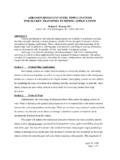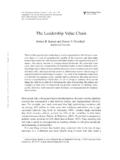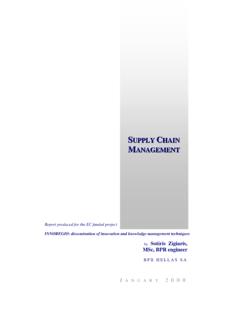Transcription of AN ANALYSIS OF STRATEGIC SUPPLIER SELECTION …
1 International Journal of Business, Marketing, and Decision Sciences Volume 3, Number 2, Fall 2010 25 A MODEL FOR QUANTIFYING STRATEGIC SUPPLIER SELECTION : EVIDENCE FROM A GENERIC PHARMACEUTICAL FIRM SUPPLY CHAIN Enyinda, Chris I. Emeka Dunu Alabama A&M University Janel Bell-Hanyes Alabama State University ABSTRACT Given t oday s e nvironment c haracterized by s upply c hain r isk, gr een i nitiatives, increasing customers value expectations, expanding regulatory compliance, and global economic crisis demand forward looking manufacturing firms to select and m aintain suite of competent suppliers. SELECTION of competent suppliers and how much supplies should be procured from a SUPPLIER or s uppliers i s an i mportant pur chasing an d s upply m anagement i ssue. Competent suppliers are the linchpin for supply chain effectiveness and the long term survival of firms. Lack of pr oper s election and e valuation of potential s uppliers c an r etard a f irm s s upply c hain performance, catapult cost, and diminish shareholder value.
2 This paper undertakes a case study on solving the SUPPLIER SELECTION process problem in a generic pharmaceutical firm leveraging the analytic hierarchy process (AHP) model and implemented with the support of the Expert Choice Software. The AHP is considered a reliable model for quantifying STRATEGIC SUPPLIER SELECTION and evaluation problem in a generic pharmaceutical firm. Keywords: INTRODUCTION Suppliers have been acknowledged as the best intangible assets of any business organization (Muralidharan et al. 2002). However, selecting the right suppliers for a long term relationship is a relevant procurement issue that demands judicious attention. According to Tahriri et al. (2008), SUPPLIER SELECTION problem has become one of the most important issues for establishing an effective supply chain system. Indeed, SUPPLIER SELECTION and evaluation represents one of the significant roles of purchasing and supply management functions (Chen and Huang, 2007; Millington et al.)
3 , 2006; Dahel, 2003; England and Leenders, 1975; Lewis, 1943). Tracey and Tan (2001) note that one of the key elements essential to supply chain success is effective purchasing function. Arguably, purchasing and supply chain plays a crucial role in supply chain management through proper SELECTION of competent suppliers. Weber, Current, and Benton, (1991) affirm that firms cannot successfully produce low cost, high quality products without judicious SELECTION and maintenance of a competent group of suppliers. Lee et al. (2001) and Kumara et al. (2003) emphasize that SELECTION of the best SUPPLIER is an essential STRATEGIC issue imperative for supply chain effectiveness and efficiency. Kumara et al. (2003) contend that STRATEGIC partnership with the right suppliers must be integrated within the supply chain to contain costs, improve quality and flexibility to meet end-customers value and reduce lead time at different stages of the supply chain.
4 Purchasing and supply management support the management of SUPPLIER network 26 International Journal of Business, Marketing, and Decision Sciences Volume 3, Number 2, Winter 2010 with respect to identification of SUPPLIER SELECTION criteria, SUPPLIER SELECTION decisions, and monitoring of SUPPLIER performance (Jose Gerardo Mart nez-Mart nez, 2007). The SELECTION process represents a multi-criteria decision making problem affected by different tangible and intangible attributes such as the traditional attributes, including quality, cost, service, flexibility, and delivery performance reported in the literature ( , Weber, Current, & Benton, 1991; Weber & Ellram, 1992; Ellram, 1990; Dickson, 1966; Ghodsypour & O Brien, 1998; Verma & Pullman, 1998; Krause & Ellram, 1997; Wilson, 1994; Min,1993; Narasimhan, 1983; Swift 1995, Soukup, 1987).
5 A number of methodologies that have been used in SUPPLIER SELECTION and evaluation studies include linear weighting models, the categorical model, weighted point model, total cost of ownership, multiple attribute utility theory, artificial neural network, principal component ANALYSIS , analytic network process (ANP), AHP, AHP/linear programming hybrid, among others. This paper uses the AHP model developed by Saaty (1980) for SUPPLIER SELECTION and evaluation in a generic pharmaceutical company in which the goal being pursued has multiple, often conflicting attributes. AHP is a multi-attribute decision making process which enables decision makers set priorities and deliver the best decision when both quantitative and qualitative aspects of a decision must be considered. AHP encompasses three basic functions, including structuring complexity, measuring on a ration scale, and synthesizing.
6 It is a powerful operational research methodology useful in structuring complex multi-criterion decisions in many fields such as purchasing and supply management, logistics and supply chain management, marketing, engineering, education, and economics. The remaining portion of this paper is organized as follows. Section 3 presents an abbreviated review of relevant literature on SUPPLIER SELECTION and evaluation. Section 4 discusses the research methodology, including case study, data collection and ANALYSIS , and research findings. Finally, section 5 presents the conclusions and implications. LITERATURE SUPPLIER SELECTION has received a significant coverage in the purchasing and supply management literature ( , Petroni & Braglia, 2000; Weber, Current, & Benton, 1991; Weber & Ellram, 1992; Ellram, 1990; Dickson, 1966; Ghodsypour & O Brien, 1998; Verma & Pullman, 1998; Krause & Ellram, 1997; Wilson, 1994; Min, 1993; Narasimhan, 1983; Swift, 1995; Soukup, 1987).
7 Based on Dickson s (1966) empirical study, 23 criteria were identified which purchasing managers generally consider when selecting a SUPPLIER . Of the identified criteria, quality, on-time delivery, and SUPPLIER s performance history were found vital in SUPPLIER SELECTION regardless of the type of purchasing environment. Dempsey (1978) identified quality, delivery capability, and technical capability as imperative in SUPPLIER SELECTION . Ellram (1990) emphasized the need not only to base SUPPLIER SELECTION decisions on the traditional price and quality criteria but also on longer term and qualitative attributes such as STRATEGIC match and evaluation of future manufacturing capabilities. Kirytopolos et al (2008) utilized ANP approach for the SELECTION and evaluation of suppliers offers in parapharmaceutical clusters.
8 The SUPPLIER SELECTION criteria considered in their study included cost, service, SUPPLIER s profile, quality, risk, and other. Their research findings indicate that quality-related issues dominated the decision making process in the parapharmaceutical industry. Their study is valuable and insightful. However, our research differs in three major ways. Our case company is a generic pharmaceutical manufacturing firm. International Journal of Business, Marketing, and Decision Sciences Volume 3, Number 2, Fall 2010 27 We integrated regulatory compliance as well as green purchasing criteria that are very important in the innovative pharmaceutical and generic pharmaceutical industries and the application of AHP model using Expert Choice Software for the SUPPLIER SELECTION process. RESEARCH METHODOLOGY A case study is a research strategy for investigating a contemporary phenomenon within its real life context, when the boundaries between phenomenon and the context are not clearly evident, and in which the multiple source of evidence are utilized (Yin, 1994).
9 Hence a case study research strategy is used to construct an analytic framework for selecting the best SUPPLIER . AHP can be used to handle relatively complex multi-attribute decision making problems. It enables a decision maker to represent the simultaneous interaction of several factors in the complex and unstructured situations. For SUPPLIER SELECTION , the derived expert judgments are introduced into the AHP model for each attribute of the hierarchy. Thus, the objective of this research is to develop AHP-based model for SUPPLIER SELECTION in a generic pharmaceutical company. SUPPLIER SELECTION process and evaluation represents a typical multi-criteria decision making that entails multiple criteria that can be both qualitative and quantitative. AHP is selected because it permits decision-makers to model a complex problem in a hierarchical structure showing the relationships of the overall goal, criteria, and alternatives.
10 Although the positive attributes associated with AHP has been widely reported in the literature, there has been a small number of descending opinions ( , Belton & Gear, 1983; Dyer & Wendel, 1985). However, because of its usefulness, AHP has been widely used in SUPPLIER SELECTION ( , Bayazit & Karpak, 2005; Bhutta & Huq, 2002; Chan, 2003; Ghodsypour et al., 1998; Nydick & Hill, 1992; Chan et al., 2007; Maggie & Tummala, 2001; Barbarosoglu & Tazgac, 1997; Onesime , 2004). The hierarchy structure for SUPPLIER SELECTION process in a generic pharmaceutical firm is composed of three levels as depicted in Figure 1. The top level contains the overall goal of the problem, the middle level houses the multiple SELECTION criteria that define the decision alternatives, and the lower level contains competing alternative suppliers.














